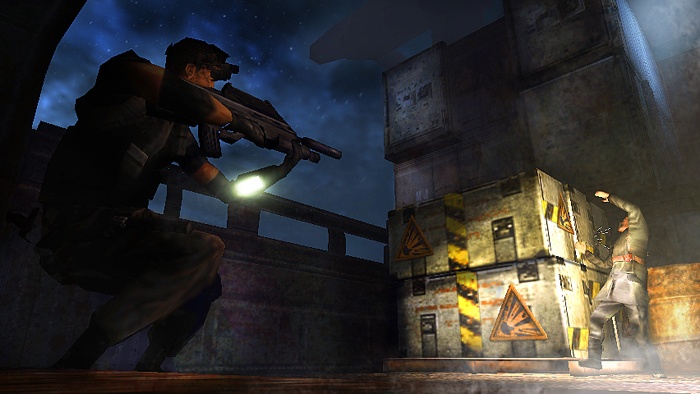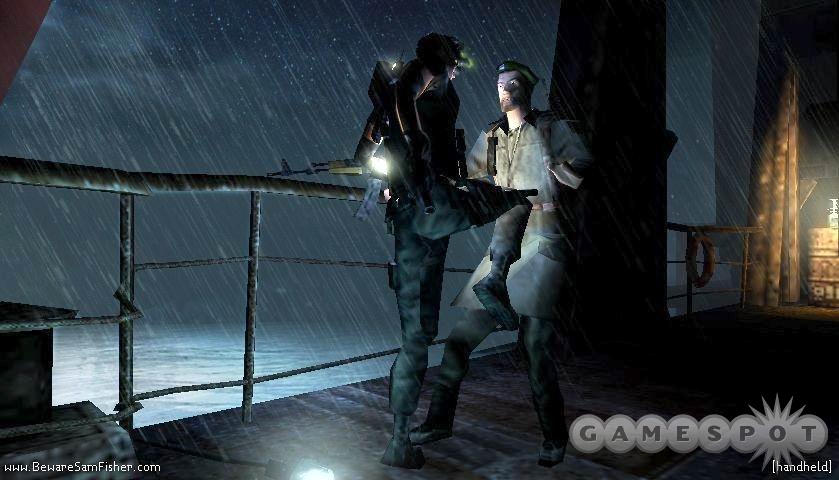Sam Fisher is best known for his exploits on consoles and the PC, but he's a veteran of the portable game world as well. With Splinter Cell releases on the N-Gage, DS, and mobile phones, it was only a matter of time before the grizzled agent sneaked his way on to the PSP. But despite what its title would have you believe, Splinter Cell Essentials is entirely avoidable.

Splinter Cell Essentials is somewhat of a Sam Fisher's Greatest Hits compilation, bringing a handful of missions from each of the three released games, as well as several brand-new missions. And, like a greatest hits album, there's no continuity or context to tie it all together. You just jump from one mission to another, spanning a couple of decades of Sam Fisher's illustrious career as a shadow-loving badass. There is an attempt to tie the missions together, but it's a weak effort. Essentials takes place just after the events in Splinter Cell: Double Agent. The game opens with Sam paying a visit to his daughter's grave on the one-year anniversary of her death. It turns out that Sam ditched the Third Echelon and went missing after his daughter died, and was reported to be associating with known terrorists. This has Homeland Security worried, so they track Sam down, arrest him, and start demanding answers about his past.
Essentials opens with Sam paying a visit to his daughter's grave on the one-year anniversary of her death. Sam doesn't have long to grieve, though, because Homeland Security agents arrest him and start demanding answers as to why he deserted Third Echelon and supposedly joined up with terrorists. The game plays out in a series of flashbacks that are set up by someone accusing Sam of some misdeed, such as killing a bunch of civilians. Sam usually replies with something along the lines of, "That's a lie, this is how it really happened..." And then you play out the mission.
There are nine missions in the story mode, plus three unlockable bonus missions. You start out with a look at one of Sam's earliest missions back in 1992 in the Colombia jungle, and progress through his career to missions taken right out of the next Splinter Cell game, Double Agent. The missions are all very linear, and mostly involve completing multiple objectives by memorizing enemy movement and occasionally finding the right ledge to hang from or ventilation duct to crawl through. There are light and sound gauges onscreen to tell you how hidden you are, and you'll come to rely on them almost exclusively at times. Just about all of Sam's moves and gadgets are intact on the PSP. He can split-jump, hang from pipes, pick locks, hack computers, silently kill or knock out enemies, and shoot guns or throw grenades--usually as a last resort.
Splinter Cell veterans will be able to breeze through most of the levels without any difficulty, despite the fact that the reused levels have been slightly tweaked in terms of enemy placement and pathways. Those who haven't played a Splinter Cell game before might get frustrated by the trial-and-error nature of the game, because it only takes a couple of shots to put Sam down, and you'll often be entering new areas completely blind. The game is made easy by absurdly myopic enemies. Sometimes you can walk right in front of an enemy, as long as you're in a shadow and are moving slowly. Other times, a guard will stand right on top of the unconscious or dead body of a fellow guard without the slightest concern. Further limiting the challenge is the ability to save your game at any time. There's a price to be paid for convenience, though, as you'll have to wait close to 30 seconds for the game to reload after you die. Load times abound elsewhere too, and they always seem to last way too long.
The controls on the PSP work fairly well, and as you might expect they're very similar to the console Splinter Cell games. You move with the analog stick and use the face buttons to perform various actions like crouching, jumping, and interacting with objects. The directional pad is used to manage inventory, pull out weapons, or switch vision modes. When you have a weapon out the camera pulls in to a first-person view where you aim with the analog stick and move with the four face buttons.
The biggest problem in the translation of the console control scheme to the PSP is the camera control. By default you control the camera by holding the circle button and moving the analog stick. That means that you can't adjust the camera while you're moving. Instead you have to stop what you're doing, hold the circle button, and move the stick around in an attempt to see what's going on. It's extremely frustrating, and at best you'll only ever find an almost-decent camera angle. There is an option to control the camera with the face buttons, which has the benefit of allowing you to move the camera on the fly, but it's still clunky because it requires you to switch out of camera mode to perform any actions.
Even if you do manage to get a view that isn't obstructed by a wall or the back of Sam's face, all you'll usually see is darkness. It makes sense that a stealth game would rely on light and shadow, but Essentials is so completely shrouded in black that you'll rarely know what you're looking at, if anything. You can remedy this by using the night-vision goggles, but those are available only in certain missions. So while Essentials might look good, you'll never know it because you'll either be looking at complete darkness, or getting the grainy greenish look afforded by night vision. Fortunately, the sound is almost good enough to play by that alone. Audio cues such as footsteps go far to improve your situational awareness, especially if you play with headphones.

If you get tired of struggling with the camera in single-player mode, you can always share the struggle with a friend in spy vs. spy mode. This is basically a two-player ad hoc deathmatch on one of four maps. The average multiplayer match boils down to a knife fight in the dark, which is every bit as clumsy and unskilled as it sounds. In multiplayer mode you do have access to the night- and heat-vision enhancements, but they're limited by a battery that has to recharge every 30 seconds or so. To make matters worse, the frame rate occasionally drops to unplayable levels and/or momentarily freezes altogether during the multiplayer matches.
Splinter Cell Essentials sounds like a fine idea. Take some missions from previous games, mix them up a little, add some entirely new missions, and fit it all onto the PSP. Unfortunately, due to some bad controls, oppressively dark levels, and a worthless multiplayer mode, the result is a game that is more frustrating than it is rewarding.